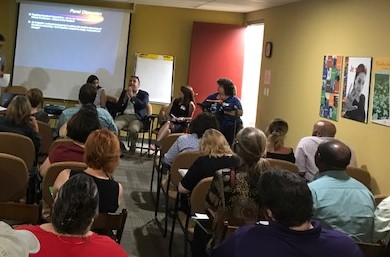Panel Discussion on Equitable & Inclusive Education
At SPNO’s Cross-Community planning session for the KNSWB Project in Burlington on August 21-22, 2017, four panelists with a breadth of knowledge and experience on the subject discussed equity and inclusion in our schools and the education system.

This discussion initiated a dialogue amongst participants that provided a good grounding for the agenda that followed on the next day.
Targeting educational interventions – do we risk “blaming the victims” of inequity & exclusion – low income children & their families?
Reframing current limitations as ongoing challenges is a more hopeful approach. The panellists agreed that there are larger systemic issues at play and if we are going to avoid “blaming the victim”, we will need to acknowledge broader social determinants of inequity and exclusion such as power and privilege. There was general agreement amongst panellists that Canada has an issue understanding what privilege means and this plays a negative role in how we approach educational interventions.
An integrated, multi-sectorial approach to address the multiple dimensions of the issue is compelling – but is it just too complex to design, implement and manage?
This question raised the principle of “Nothing about us, without us”. The panellists discussed how despite the complexity of the issues around inequity and exclusion it is very important to ensure youth are at the table when designing and managing our approach to tackling these topics.
How does the extensive American literature and examples on the issue reflect and/or vary from the Canadian experience?
The panellists generally agreed that there needs to be more Canadian data collected on the topic of inequities and exclusion and in places where this data already exists, we need to find ways of openly sharing this information. One panellist stated: “no data, no problem, no actions”. Without data, we cannot identify problems and without problem identification, we cannot facilitate action.
How can we strengthen the connections between researchers, educators, students and parents in community to generate and mobilize local knowledge?
It is important to make sure that the people being discussed are actually at the table. Apply the principle of “Nothing about us, without us”. It was generally agreed that finding ways of engaging students was the toughest part of this equation. It is important to build trust among the different levels and all players in order to be able to create change and move things along.
What must change in the culture of the education system and its institutional framework before true shifts in policy and practice for equity & inclusion will occur?
School boards are often presented with a “laundry list” of changes and improvements but there is no support system to implement these suggestions, so change is not created. It was acknowledged that there are policies already available that are simply not being used. Also raised was the fact that Indigenous students struggle to see themselves represented in the culturally western curriculum, which creates further inequity and exclusion for these students. It was noted that there is a 30% differential between funding for Indigenous children and all other children.
Audience questions and comments following the panel’s responses to the above included:
- Why is demographic data not collected by all school boards?
Language may be a barrier when attempting to collect data. There was some indication that school boards may be waiting for direction from the Ministry with regards to clearly defining language. However it was also suggested that it would be best to move forward with data collection rather than waiting for these definitions. [Notably, since the Burlington event the Ministry of Education has released its Equity Action Plan, which does support voluntarily provided data collection on the student population, including data on socioeconomic status]
- What is being done (What could be done?) to include disadvantaged students and their families into conversations about inequity and exclusion?
We need to find ways of creating collaborative partnerships among all the stakeholders rather than hierarchical relationships in which educators hold the higher ground. SPNO’s commitment is to support local “Communities of Practice” that engage, involve and support students and parents as equals in the thinking and conversation on a more equitable and inclusive education system.
- How can we move toward an education system that is more responsive to individual student’s personal circumstances?
School boards should feel responsible for the failure or success of their students. We need to find ways of reinforcing the fact that school boards have a responsibility to meet the learning needs of students rather than strictly blaming students for their failures.